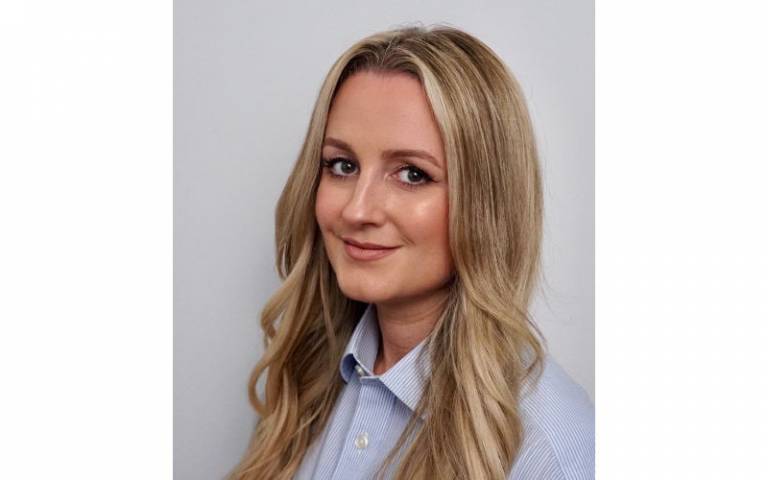Welcome to new Birkbeck Lecturer, Dr Lauren Mc Keown
7 July 2021
The CPS welcomes Dr Lauren Mc Keown as a new Lecturer in Planetary Surfaces, in the Department of Earth and Planetary Sciences at Birkbeck, from August 2021.

Lauren is a planetary scientist with an interest in studying icy planetary surface processes through remote-sensing and laboratory analogue work. She has a cross-disciplinary background, with a PhD on the topic of Martian geomorphology from Trinity College Dublin and a degree in Physics with Astronomy and Space Science from University College Dublin. She has had research experience at NASA Ames, The Natural History Museum and The Open University and has also worked in project management at The University of Cambridge.
Lauren's research concerns planetary surface processes that have no Earth analogues; particularly those driven by seasonal ice dynamics. Her main research area focuses on seasonal Martian surface features; namely linear dune gullies, sand furrows and spiders, studying these features through a combination of repeat high-resolution orbital imaging of the Martian surface and laboratory analogue work. In recent work, she replicated the formation of spiders under Mars conditions at the Open University Mars Simulation Chamber:
Spiders are large, dendritic features specific to the Martian south polar regions from which dark fans and blotches emanate in spring. They are believed to be formed when sunlight penetrates the Martian seasonal CO2 ice layer. The regolith beneath the layer will warm, causing the ice to change to gas at the interface between the ice and the sandy substrate and a pressure buildup will cause the ice to rupture, allowing gas to erode the surface to form the dendritic tortuous channels that make up spider patterns. This formation hypothesis has been well-accepted for a long time, but has never been directly observed on Mars. I investigated whether spider-like patterns would develop on the small scale, when CO2 ice with a central vent was allowed to sublimate on granular substrate under Martian atmospheric pressure. I found that spider-like patterns were indeed formed by the interaction between pressurised escaping CO2 gas and a sandy surface, and that the level of branching of these features depended on vent width and grain size. The data obtained from these experiments will help us to understand more about how the surface of Mars is being modified today.
Teaching and science communication are an important focus of Lauren's career:
I am passionate about STEM outreach and creating a more equitable, diverse and inclusive culture in academia. I am excited to continue to share my knowledge of geology, geomorphology and exploration of the Solar System and to carry forward my long-standing passion for engaging students and the general public with planetary science.
Lauren has been teaching Geology of the Solar System II temporarily at Birkbeck since January of this year and in her new permanent role as Lecturer in Planetary Surfaces from August, she will be teaching Geology of the Solar System II and Remote Sensing and Planetary Surfaces. As Birkbeck’s teaching requirements expand, she will contribute to teaching new modules.
We asked Lauren what she was looking forward to most in her new post:
I am really looking forward to contributing to new ideas surrounding teaching at Birkbeck. I am excited to contribute to evolving teaching methodologies and subject matter that fits with the changing landscape of planetary science. For example, I look forward to hopefully further exploring my interest in planetary analogue laboratory research; a relatively recent approach to understanding planetary surface processes. I see a lot of room to collaborate with experts on planetary analogue field work in the department of Earth and Planetary Sciences; both through research and teaching. Additionally, I am fascinated by surface processes on icy moons and would love to apply my knowledge of icy processes on Mars, to pursuing research in this area, perhaps through collaborations with the many experts from MSSL and UCL at the Centre for Planetary Sciences. Joining the Department of Earth and Planetary Sciences at Birkbeck offers many opportunities and paths forward, both in growing as a lecturer and researcher and I really look forward to beginning my position.
Links
- Dr Lauren Mc Keown's website
- 'Spiders on Mars' Nature article: McKeown, L., McElwaine, J.N., Bourke, M.C. et al. The formation of araneiforms by carbon dioxide venting and vigorous sublimation dynamics under martian atmospheric pressure. Sci Rep 11, 6445 (2021).
- The Department of Earth and Planetary Sciences, Birkbeck
 Close
Close

